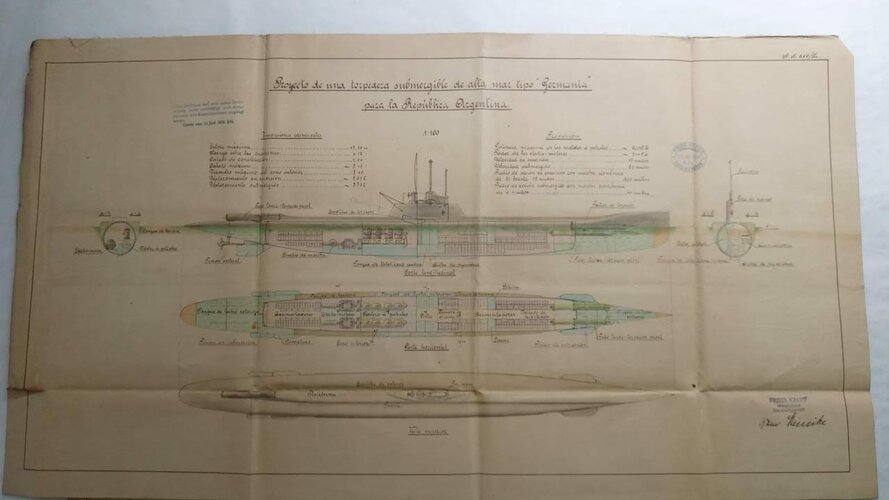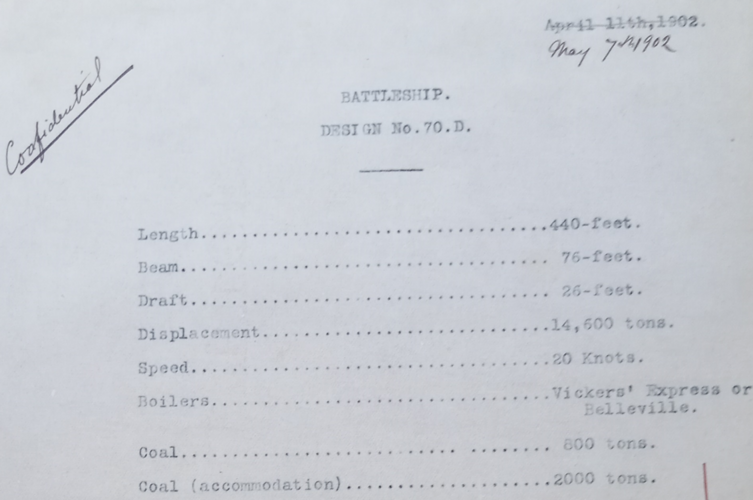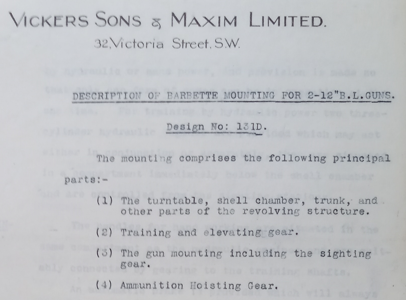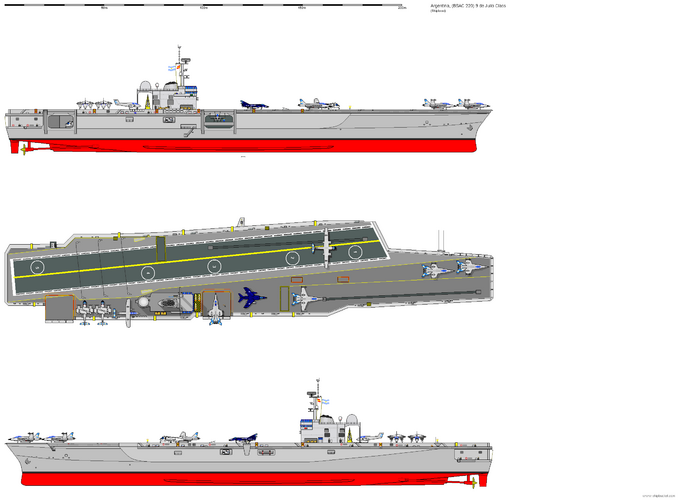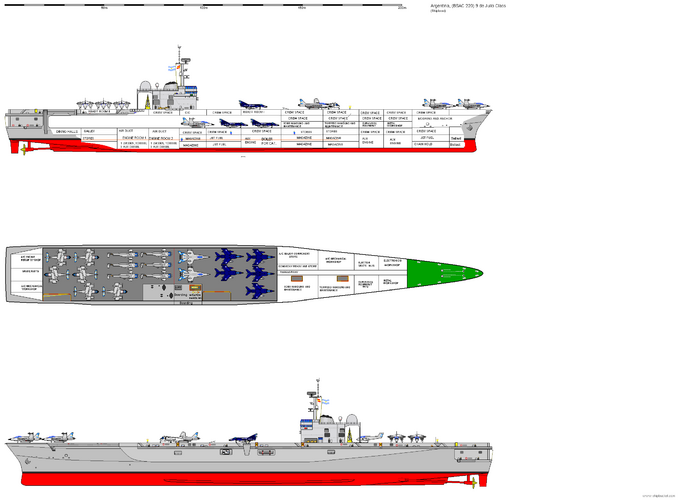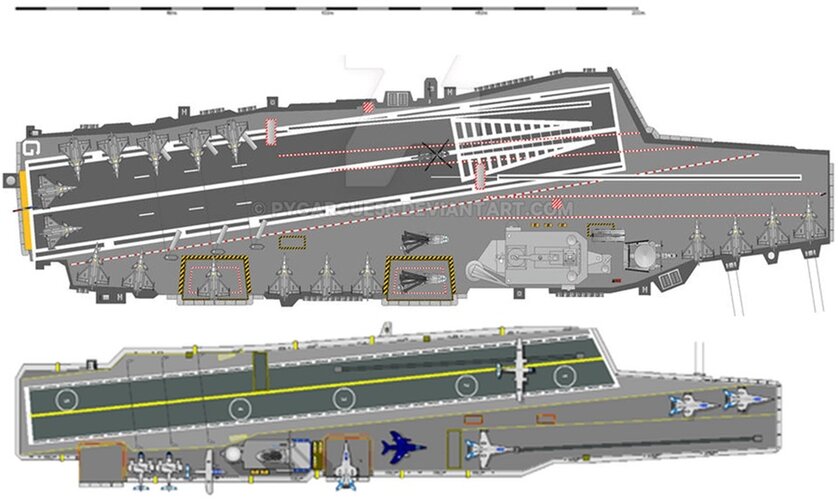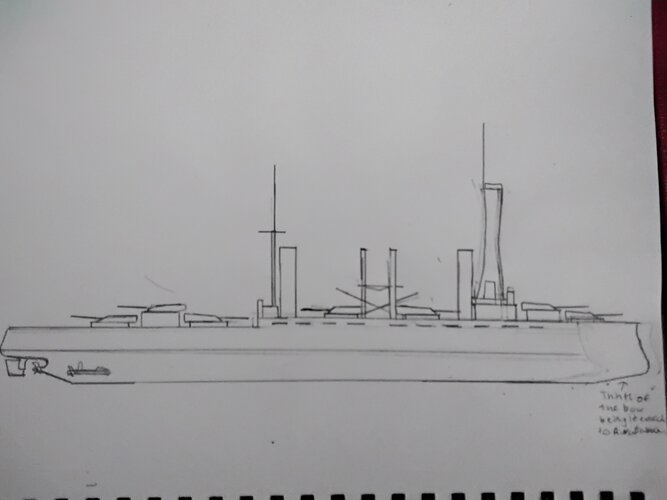Argentina didn't order the 3rd Dreadnought when Brazil ordered Rio. Rivadavia and Moreno were ordered only after Brazil's first two ships were complete. Based on this pattern, Argentina wouldn't order the 3rd ship till Riachuelo would be complete in about 1917.
When in 1910 the Brazilian Navy was ordering the 653-Modified design (with 6xII 356mm) and when, in turn, the Chilean Navy was consulting for superdreadnoughts to be manufactured in the United States (with 5xII 356mm), the Navy Argentina calls on the
American shipyards to provide an effective response to the former and requests the general schemes of the latter.
Thus, at the end of 1910 the schemes for a third (or even fourth) Argentine battleship ranged from 5xII to 6xII 356mm distributed in a central line or echelon.
The general platform would have been practically identical to that of the Rivadavia (with 6xII 305mm), since Fore River Shipyard (designs 6321, 6321-A, 6321-B, 6322, 6322-A and 6322-B) and New York Shipyard (designs 3012, 3012-A, 3012-B, 3013, 3013-A) offered the same costs as before.
At the beginning of 1911, the Brazilians changed their design for their third battleship to the 690-A (with 7xII 305mm) and the Argentines reconsidered maintaining their base design (with 305mm). Let us remember that Argentina had the
approved budget for the construction of a third battleship (not for a fourth, still) and that the contract with the manufacturers ratified and extended the deadlines for this request.
Around 1912 and 1913, with the construction of the Rio de Janeiro already advanced, proposals for
battleship designs with 305mm or 356mm coexisted, but this time with 14 guns (2xIII and 4xII). Unlike previous designs, this vessel would have been larger than the previous platform (aka Rivadavia hull).
The
lobbying of the Brazilian admiralty for the acquisition of a third and fourth battleship (respectively Rio de Janeiro and Riachuelo) is found in public records dating back to 1911, but it can be assumed from earlier in private spheres. And Argentina was not unaware of this circumstance.
The strange thing is that the bilateral diplomatic relations of those years worked very hard for Brazil to sell the third battleship and when this happened in 1913, for many historians of this region, the arms race ended. However, in 1914 Brazil "skipped" a third dreadnought and ordered the Riachuelo, a ship that would have broken with the diplomatic efforts and jumped the technological evolution of those years.
By this stage Argentina may be ordering a ship or two (Brazil Navy League agitating for a second Riachuelo) with 16" guns but more likely a 13 gun Italian style layout but with 14" guns perhaps styled like a stretch Nevada (23knots) with a triple midship turret with funnels at either end.
In the Argentine Navy they knew of the difference in power from one caliber to another (initially from 305mm to 356mm, later from 356mm to 381mm or 406mm), but their maxim was that
their own cannons had a more favorable sustained rate of fire than their rival.
Starting from the specific case, the Brazilian Pattern L guns (Minas Geraes class) and, by extension, the Pattern W guns (Rio de Janeiro class) of those years had a rate of fire of 1.5 to 2.0 rounds per minute against the Marca L guns (Rivadavia class) that had a rate of fire that would have reached 2.0 rounds per minute with more sustain. In addition, the Argentine cannons would have had heavier projectiles with greater muzzle velocity and range.
When at the end of 1910 the Brazilians were thinking of incorporating battleships with better weapons, the Argentine Navy considered modifying the design of the two battleships under construction towards a higher caliber (14 inches), but it was
the superior speed of fire of the smaller caliber (12 inches) one of the axles that generated the rejection of this repowering. For more details, the Rio de Janeiro 653-Modified the Brazilians calculated a rate of fire of 1.35 rounds per minute with 700 or 635 kilogram projectiles of 356 millimeters. These would have been 16.2 Brazilian projectiles (11,300 to 10,300 kilogram volley) against 24.0 Argentine projectiles (9,500 kilograms of projectiles). Here the range would have been favorable to the Brazilians, but the difference in the mass of projectiles would not have been so critical (between 15 to 10%). Furthermore, if Argentina had chosen to increase the caliber of its battleships, the 356mm Mark I guns would have kept the ratio equal, so none of the above was important enough to influence the redesign of the Argentine battleships.
Of course, a
Brazilian jump to the calibers of 381 and 406 millimeters would have been a critical issue for the Argentine admiralty. However, I do not remember having seen information of a caliber greater than the 356 of the American Mark I for Argentine battleships. Even though there are details of the Ansaldo+Schneider 381mm/45 Superdreadnought guns from 1912 in the Argentine records (but the reason for their existence is not clear to me). Regarding the characteristics of the Brazilian guns, these would have been 381mm/45cs with 780 or 885 kilogram projectiles or 406mm/40cs with 998 kilogram projectiles. The muzzle velocities would have been lower than the aforementioned cannons, but their range would have been greater. However, the rate of fire would have been 1.2 rounds per minute, according to Brazilian sources.
In my opinion, I do not believe that
Argentina would have opted for those calibers due to such firing rates, even if they were projectiles that weighed twice as much as the Argentine ones. So I agree with Dorknought in the 14" caliber topic.
Regarding the turrets, those
with double assemblies were more acceptable to the admiralty, because in the event of one turret being hit, more muzzles of fire would be surviving in the others, which in the case of a triple tower this would have been a worse scenario. Although it is true that the triple towers meant a saving of space (that is why in the 1912/1913 designs they were intended to be used only at the bow and stern ends).
Having said all the above, in the mid-1920s, the Argentine Navy considered the acquisition of a third battleship again. One of the alternatives was a "Fast battleship" (disp 28,000 t, speed 25.5 kn, range 6,000 nm, main guns 4xII 381mm, sec guns 12/16xI 152mm, AA guns, belt 330 bb, 2-4 aircraft). If it doesn't look
like Riachuelo, I'm crazy.
---
Clearly I make a reduction of the characteristics and ballistics of the cannons and their grenades and projectiles. But I do so in order to highlight that, according to the publications of the time, the caliber was not as relevant, as the fire rate or, of course, the number of units could have been.



